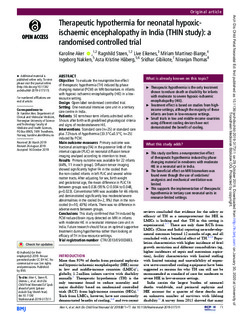| dc.contributor.author | Aker, Karoline | |
| dc.contributor.author | Støen, Ragnhild | |
| dc.contributor.author | Eikenes, Live | |
| dc.contributor.author | Martinez-Biarge, Miriam | |
| dc.contributor.author | Nakken, Ingeborg Elise | |
| dc.contributor.author | Håberg, Asta | |
| dc.contributor.author | Gibikote, Sridhar | |
| dc.contributor.author | Thomas, Niranjan | |
| dc.date.accessioned | 2020-01-31T11:19:37Z | |
| dc.date.available | 2020-01-31T11:19:37Z | |
| dc.date.created | 2019-11-14T15:28:35Z | |
| dc.date.issued | 2019 | |
| dc.identifier.citation | Archives of Disease in Childhood: Fetal and Neonatal Edition | nb_NO |
| dc.identifier.issn | 1359-2998 | |
| dc.identifier.uri | http://hdl.handle.net/11250/2639037 | |
| dc.description.abstract | OBJECTIVE: To evaluate the neuroprotective effect of therapeutic hypothermia (TH) induced by phase changing material (PCM) on MRI biomarkers in infants with hypoxic-ischaemic encephalopathy (HIE) in a low-resource setting. DESIGN: Open-label randomised controlled trial. SETTING: One neonatal intensive care unit in a tertiary care centre in India. PATIENTS: 50 term/near-term infants admitted within 5 hours after birth with predefined physiological criteria and signs of moderate/severe HIE. INTERVENTIONS: Standard care (n=25) or standard care plus 72 hours of hypothermia (33.5°C±0.5°C, n=25) induced by PCM. MAIN OUTCOME MEASURES: Primary outcome was fractional anisotropy (FA) in the posterior limb of the internal capsule (PLIC) on neonatal diffusion tensor imaging analysed according to intention to treat. RESULTS: Primary outcome was available for 22 infants (44%, 11 in each group). Diffusion tensor imaging showed significantly higher FA in the cooled than the non-cooled infants in left PLIC and several white matter tracts. After adjusting for sex, birth weight and gestational age, the mean difference in PLIC FA between groups was 0.026 (95% CI 0.004 to 0.048, p=0.023). Conventional MRI was available for 46 infants and demonstrated significantly less moderate/severe abnormalities in the cooled (n=2, 9%) than in the non-cooled (n=10, 43%) infants. There was no difference in adverse events between groups. CONCLUSIONS: This study confirmed that TH induced by PCM reduced brain injury detected on MRI in infants with moderate HIE in a neonatal intensive care unit in India. Future research should focus on optimal supportive treatment during hypothermia rather than looking at efficacy of TH in low-resource settings. TRIAL REGISTRATION NUMBER: CTRI/2013/05/003693. | nb_NO |
| dc.language.iso | eng | nb_NO |
| dc.publisher | BMJ Journals | nb_NO |
| dc.rights | Navngivelse-Ikkekommersiell 4.0 Internasjonal | * |
| dc.rights.uri | http://creativecommons.org/licenses/by-nc/4.0/deed.no | * |
| dc.title | Therapeutic hypothermia for neonatal hypoxic-ischaemic encephalopathy in India (THIN study): a randomised controlled trial | nb_NO |
| dc.type | Journal article | nb_NO |
| dc.type | Peer reviewed | nb_NO |
| dc.description.version | publishedVersion | nb_NO |
| dc.source.journal | Archives of Disease in Childhood: Fetal and Neonatal Edition | nb_NO |
| dc.identifier.doi | 10.1136/archdischild-2019-317311 | |
| dc.identifier.cristin | 1747686 | |
| dc.description.localcode | Copyright information: © Author(s) (or their employer(s)) 2019. Re-use permitted under CC BY-NC. No commercial re-use. See rights and permissions. Published by BMJ. | nb_NO |
| cristin.unitcode | 194,65,15,0 | |
| cristin.unitcode | 1920,1,0,0 | |
| cristin.unitcode | 194,65,25,0 | |
| cristin.unitcode | 1920,4,0,0 | |
| cristin.unitcode | 194,65,30,0 | |
| cristin.unitname | Institutt for klinisk og molekylær medisin | |
| cristin.unitname | Barne- og ungdomsklinikken | |
| cristin.unitname | Institutt for sirkulasjon og bildediagnostikk | |
| cristin.unitname | Klinikk for bildediagnostikk | |
| cristin.unitname | Institutt for nevromedisin og bevegelsesvitenskap | |
| cristin.ispublished | true | |
| cristin.fulltext | original | |
| cristin.qualitycode | 1 | |

